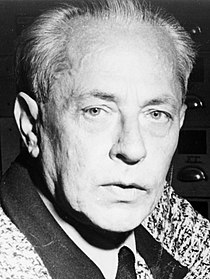Heinrich Hoffmann | |
|---|---|
 Hoffmann in 1945 during the Nuremberg trials | |
| Born | 12 September 1885 |
| Died | 16 December 1957 (aged 72) |
| Resting place | Nordfriedhof |
| Alma mater | Heidelberg University |
| Occupation | Photographer |
| Years active | 1903–1945 |
| Known for | Hitler's personal photographer |
| Political party | Nazi Party |
| Criminal status | Deceased |
| Spouses | Therese Baumann
(m. 1911; died 1928)Erna Gröbke (m. 1929) |
| Children | 2, including Henriette von Schirach |
| Conviction(s) | War profiteering |
| Criminal penalty | 10 years imprisonment; commuted to 4 years imprisonment |
| Military career | |
| Allegiance | German Empire |
| Branch | Imperial German Army |
| Years of service | 1917–1918 |
| Unit | Fliegerersatz-Abteilung I |
| Battles / wars | World War I |
Heinrich Hoffmann (12 September 1885 – 16 December 1957) was Adolf Hitler's official photographer, and a Nazi politician and publisher, who was a member of Hitler's intimate circle. Hoffmann's photographs were a significant part of Hitler's propaganda campaign to present himself and the Nazi Party as a significant mass phenomenon. He received royalties from all uses of Hitler's image, which made him a millionaire over the course of Hitler's rule. After the Second World War he was tried and sentenced to 10 years in prison for war profiteering. He was classified by the Allies' Art Looting Investigators to be a "major offender" in Nazi art plundering of Jews,[1] as both art dealer and collector and his art collection, which contained many artworks looted from Jews, was ordered confiscated by the Allies.
Hoffmann's sentence was reduced to 4 years on appeal, and he was released from prison in 1950. In 1956, the Bavarian State ordered all art under its control and formerly possessed by Hoffmann to be returned to him.[2]
- ^ Siegal, Nina (24 March 2019). "A Painting Looted by and Returned to Nazis Finally Goes to Its Jewish Owners - The New York Times". The New York Times. Archived from the original on 24 March 2019. Retrieved 13 May 2021.
The Kraus family fled Austria in March 1938, when Nazi Germany annexed Austria, leaving their collection behind. Three years later, the Gestapo seized it and sold it; the van der Heyden painting went to Hitler's friend and photographer, Heinrich Hoffmann.
- ^ Winter, Steffen (30 January 2013). "A Nazi Legacy Hidden in German Museums". Der Spiegel. Retrieved 18 June 2017.